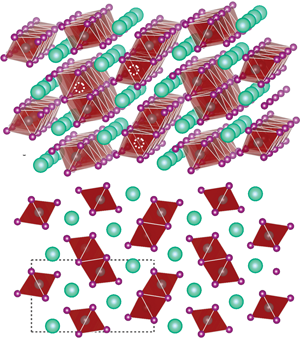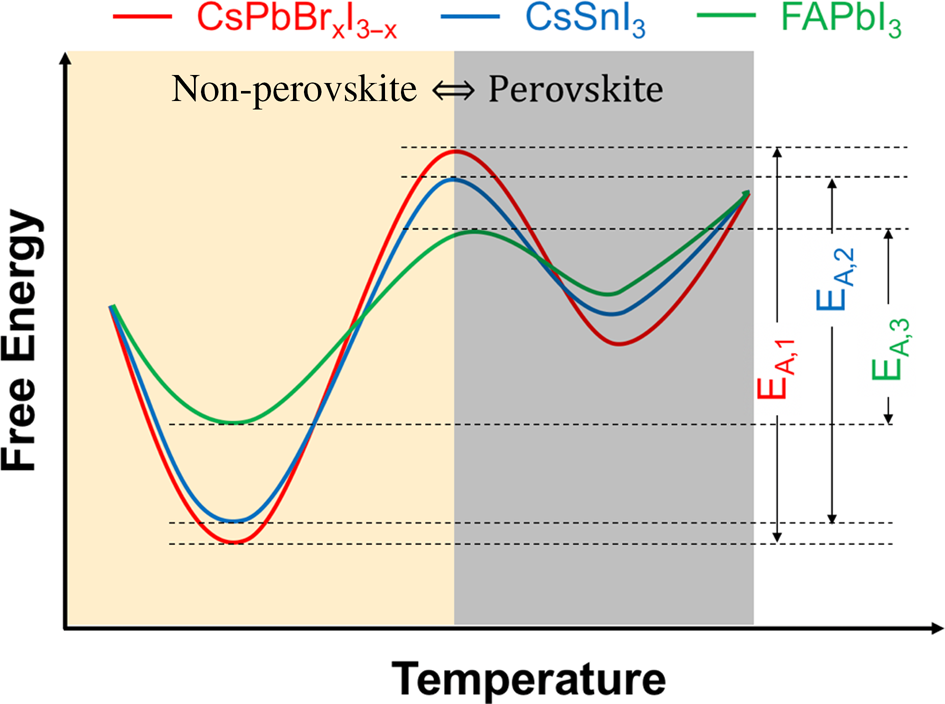Structural phase transitions in semiconductors have been utilized for driving technological advancements in switchable electronics and phase-change memory devices. There have been numerous reports on high susceptibility of halide perovskites to phase transitions because of their soft lattice; however, the factors affecting the underlying process are still poorly understood. Insights into the phase transition dynamics of halide perovskites are desirable for precise control of optoelectronic properties and for unlocking their use in novel solid-state applications.
The article by Lai et al.Reference Lai, Lei, Zhang, Jin, Steele and Yang1 reports on a systematic evaluation of the phase transition dynamics between low-temperature (low-T) and high-temperature (high-T) phases of CsSnI3 and FAPbI3 nanowires. Their quantitative estimation reveals a lower kinetic energy barrier for non-perovskite (low-T) to perovskite (high-T) phase transition in FAPbI3 owing to the relatively smaller activation energy in FAPbI3 (~0.84 eV) compared to CsSnI3 (~1.93 eV).Reference Lai, Lei, Zhang, Jin, Steele and Yang1
The solid-solid phase transitions triggered by thermal energy, electric field, optical excitation, and strain have been extensively studied in metal oxides, transition metal dichalcogenides, and GeSbTe alloys.Reference Li, Duerloo, Wauson and Reed2 The contrast in electrical and optical properties offered by phase engineering of these materials has led to the fabrication of innovative functional devices. Electrochromic smart windows have been demonstrated using the metal-insulator transition in VO2 films.Reference Chen, Wang, Ren, Chen, Yan, Wang, Li, Jiang and Zou3 Cho et al. has fabricated a high mobility transistor by realizing a laser irradiation-induced homojunction between metal-semiconductor phases of MoTe2.Reference Cho, Kim, Kim, Zhao, Seok, Keum, Baik, Choe, Chang, Suenaga, Kim, Lee and Yang4 The amorphous to crystalline phase change due to Joule heating of Ge2Sb2Te5 nanowires has been used for non-volatile memory devices.Reference Lee, Jung and Agarwal5 One of the latest additions to these phase-change materials are halide perovskites, which have gained tremendous attention in the last decade because of their exceptional optoelectronic properties. However, unlike their counterparts, the relative ease of phase transition in halide perovskites is typically considered undesirable due to its detrimental impact on long-term stability.Reference Park and Seok6 Insights about the thermodynamics of phase transitions between different halide perovskite polymorphs will not only tackle the perovskite stability issue but will also open up opportunities for novel solid-state applications.
To investigate the phase transition dynamics in halide perovskites, Lai et al.Reference Lai, Lei, Zhang, Jin, Steele and Yang1 employed non-invasive in situ optical microspectroscopy. They chose two model systems—CsSnI3 and FAPbI3—to study the impact of crystal structure and defect types on phase transition and phase propagation. Using thermal activation followed by quenching, a partial phase transition and heterojunction formation was obtained in FAPbI3. Compared to the high-T perovskite phase, a significant blue-shift (~38 meV) in photoluminescence spectrum is observed at the two-phase heterojunction. Interestingly, the origin of increased band gap at heterojunction is attributed to lattice distortion because of octahedral titling at the boundary of face-sharing non-perovskite and corner-sharing perovskite phases. The presence of Sn vacancies in CsSnI3 leads to approximately three orders of magnitude higher phase propagation rate compared to ion-diffusion-mediated phase growth in previously reported CsPbBr2I.Reference Bischak, Lai, Lu, Fan, David, Dong, Chen, Etman, Lei, Sun, Grünwald, Limmer, Yang and Ginsberg7 Temperature-dependent phase propagation rate is used to estimate the activation energy barrier for phase transition. Figure 1 compares the calculated activation energy barriers for phase transition in FAPbI3 (~0.84 eV), CsSnI3 (~1.93 eV), and CsPbBr2I (~2.18 eV).Reference Bischak, Lai, Lu, Fan, David, Dong, Chen, Etman, Lei, Sun, Grünwald, Limmer, Yang and Ginsberg7 This indicates that the face-sharing to corner-sharing phase transition in FAPbI3 offers a much smaller energy barrier compared to edge-sharing to corner-sharing phase transitions for CsSnI3 and CsPbBr2I.
Figure 1. Schematic representation of an activation energy barrier for phase transition in typical halide perovskites.
Through their research, Lai et al.Reference Lai, Lei, Zhang, Jin, Steele and Yang1 highlight the governing role of crystal structure and inherent vacancies in phase transition of halide perovskites. Precise controlling of phase transition dynamics can be used to locally change the crystal structure and improve intrinsic material properties. For instance, epitaxial stabilization and strain neutralization have already been employed for demonstrating the enhanced performance of FAPbI3-based photodetectors.Reference Chen, Lei, Li, Yu, Cai, Chiu, Rao, Gu, Wang, Choi, Hu, Wang, Li, Song, Zhang, Qi, Lin, Zhang, Islam, Maruyama, Dayeh, Li, Yang, Lo and Xu8 Phase engineering can also be used for fabrication of high-quality perovskite-based heterojunctions with potential applications in new functional devices.Reference Shi, Yuan, Shiring, Gao, Akriti, Guo, Su, Lai, Yang, Kong, Savoie, Yu and Dou9,Reference Kennard, Dahlman, Nakayama, DeCrescent, Schuller, Seshadri, Mukherjee and Chabinyc10








Structural phase transitions in semiconductors have been utilized for driving technological advancements in switchable electronics and phase-change memory devices. There have been numerous reports on high susceptibility of halide perovskites to phase transitions because of their soft lattice; however, the factors affecting the underlying process are still poorly understood. Insights into the phase transition dynamics of halide perovskites are desirable for precise control of optoelectronic properties and for unlocking their use in novel solid-state applications.
The article by Lai et al.Reference Lai, Lei, Zhang, Jin, Steele and Yang1 reports on a systematic evaluation of the phase transition dynamics between low-temperature (low-T) and high-temperature (high-T) phases of CsSnI3 and FAPbI3 nanowires. Their quantitative estimation reveals a lower kinetic energy barrier for non-perovskite (low-T) to perovskite (high-T) phase transition in FAPbI3 owing to the relatively smaller activation energy in FAPbI3 (~0.84 eV) compared to CsSnI3 (~1.93 eV).Reference Lai, Lei, Zhang, Jin, Steele and Yang1
The solid-solid phase transitions triggered by thermal energy, electric field, optical excitation, and strain have been extensively studied in metal oxides, transition metal dichalcogenides, and GeSbTe alloys.Reference Li, Duerloo, Wauson and Reed2 The contrast in electrical and optical properties offered by phase engineering of these materials has led to the fabrication of innovative functional devices. Electrochromic smart windows have been demonstrated using the metal-insulator transition in VO2 films.Reference Chen, Wang, Ren, Chen, Yan, Wang, Li, Jiang and Zou3 Cho et al. has fabricated a high mobility transistor by realizing a laser irradiation-induced homojunction between metal-semiconductor phases of MoTe2.Reference Cho, Kim, Kim, Zhao, Seok, Keum, Baik, Choe, Chang, Suenaga, Kim, Lee and Yang4 The amorphous to crystalline phase change due to Joule heating of Ge2Sb2Te5 nanowires has been used for non-volatile memory devices.Reference Lee, Jung and Agarwal5 One of the latest additions to these phase-change materials are halide perovskites, which have gained tremendous attention in the last decade because of their exceptional optoelectronic properties. However, unlike their counterparts, the relative ease of phase transition in halide perovskites is typically considered undesirable due to its detrimental impact on long-term stability.Reference Park and Seok6 Insights about the thermodynamics of phase transitions between different halide perovskite polymorphs will not only tackle the perovskite stability issue but will also open up opportunities for novel solid-state applications.
To investigate the phase transition dynamics in halide perovskites, Lai et al.Reference Lai, Lei, Zhang, Jin, Steele and Yang1 employed non-invasive in situ optical microspectroscopy. They chose two model systems—CsSnI3 and FAPbI3—to study the impact of crystal structure and defect types on phase transition and phase propagation. Using thermal activation followed by quenching, a partial phase transition and heterojunction formation was obtained in FAPbI3. Compared to the high-T perovskite phase, a significant blue-shift (~38 meV) in photoluminescence spectrum is observed at the two-phase heterojunction. Interestingly, the origin of increased band gap at heterojunction is attributed to lattice distortion because of octahedral titling at the boundary of face-sharing non-perovskite and corner-sharing perovskite phases. The presence of Sn vacancies in CsSnI3 leads to approximately three orders of magnitude higher phase propagation rate compared to ion-diffusion-mediated phase growth in previously reported CsPbBr2I.Reference Bischak, Lai, Lu, Fan, David, Dong, Chen, Etman, Lei, Sun, Grünwald, Limmer, Yang and Ginsberg7 Temperature-dependent phase propagation rate is used to estimate the activation energy barrier for phase transition. Figure 1 compares the calculated activation energy barriers for phase transition in FAPbI3 (~0.84 eV), CsSnI3 (~1.93 eV), and CsPbBr2I (~2.18 eV).Reference Bischak, Lai, Lu, Fan, David, Dong, Chen, Etman, Lei, Sun, Grünwald, Limmer, Yang and Ginsberg7 This indicates that the face-sharing to corner-sharing phase transition in FAPbI3 offers a much smaller energy barrier compared to edge-sharing to corner-sharing phase transitions for CsSnI3 and CsPbBr2I.
Figure 1. Schematic representation of an activation energy barrier for phase transition in typical halide perovskites.
Through their research, Lai et al.Reference Lai, Lei, Zhang, Jin, Steele and Yang1 highlight the governing role of crystal structure and inherent vacancies in phase transition of halide perovskites. Precise controlling of phase transition dynamics can be used to locally change the crystal structure and improve intrinsic material properties. For instance, epitaxial stabilization and strain neutralization have already been employed for demonstrating the enhanced performance of FAPbI3-based photodetectors.Reference Chen, Lei, Li, Yu, Cai, Chiu, Rao, Gu, Wang, Choi, Hu, Wang, Li, Song, Zhang, Qi, Lin, Zhang, Islam, Maruyama, Dayeh, Li, Yang, Lo and Xu8 Phase engineering can also be used for fabrication of high-quality perovskite-based heterojunctions with potential applications in new functional devices.Reference Shi, Yuan, Shiring, Gao, Akriti, Guo, Su, Lai, Yang, Kong, Savoie, Yu and Dou9,Reference Kennard, Dahlman, Nakayama, DeCrescent, Schuller, Seshadri, Mukherjee and Chabinyc10